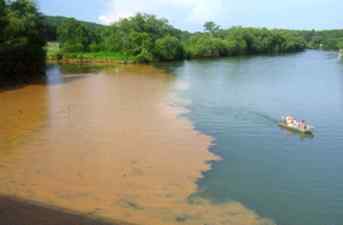Week 4a- Water
Abschlussbedingungen
1. Water
1.14. Further Effects
 Effects on sediment movement within the river
Effects on sediment movement within the riverThe principal effect of the proposed abstraction in relation to sedimentation will be due to the reduced flow velocity and thus sediment carrying capacity of the flow. However, analysis discussed above shows that the reduction in velocity will be ~ 0.002 m/s at low flows, which amounts to a reduction of less than 0.5 %. This effect will be less at higher flows, when greater sediment loads are likely in the river. The effects of the proposed abstraction on sedimentation will be minor in comparison with other factors influencing sediment movement in the River, including sand abstraction (image from Sherpaguides.com of the sedimentation of the Chattahoochee River).
Effects on Water Quality
In order to determine the effects of the proposed abstraction on temperature and dissolved oxygen levels in the river, the computer software SEFA (System for Environmental Flow Analysis) has been used. SEFA implements the Instream Flow Incremental Methodology (IFIM) to provide a set of tools that allow the effects of flow alteration on various physical parameters to be assessed.
With respect to water temperature the modelling indicates that abstraction of an additional 200,000 m3/day (net) will, at a distance of 10 km or 20 km downstream of the intake, cause a maximum temperature change of less than 0.01 °C.
With respect to dissolved oxygen levels, the modelling indicates that the reduction of flows in the Waikato River brought about by the proposed water take of 200,000 m3/day (net) in combination with the existing Watercare water take from the river would result in a reduction in dissolved oxygen concentration of less than 0.002 mg/L.
Overall, taking into account variations in tidal effects and average water depths and velocities, these predicted changes will have no significant effect on water temperature, and changes in dissolved oxygen levels will be largely undetectable to wildlife or river users.